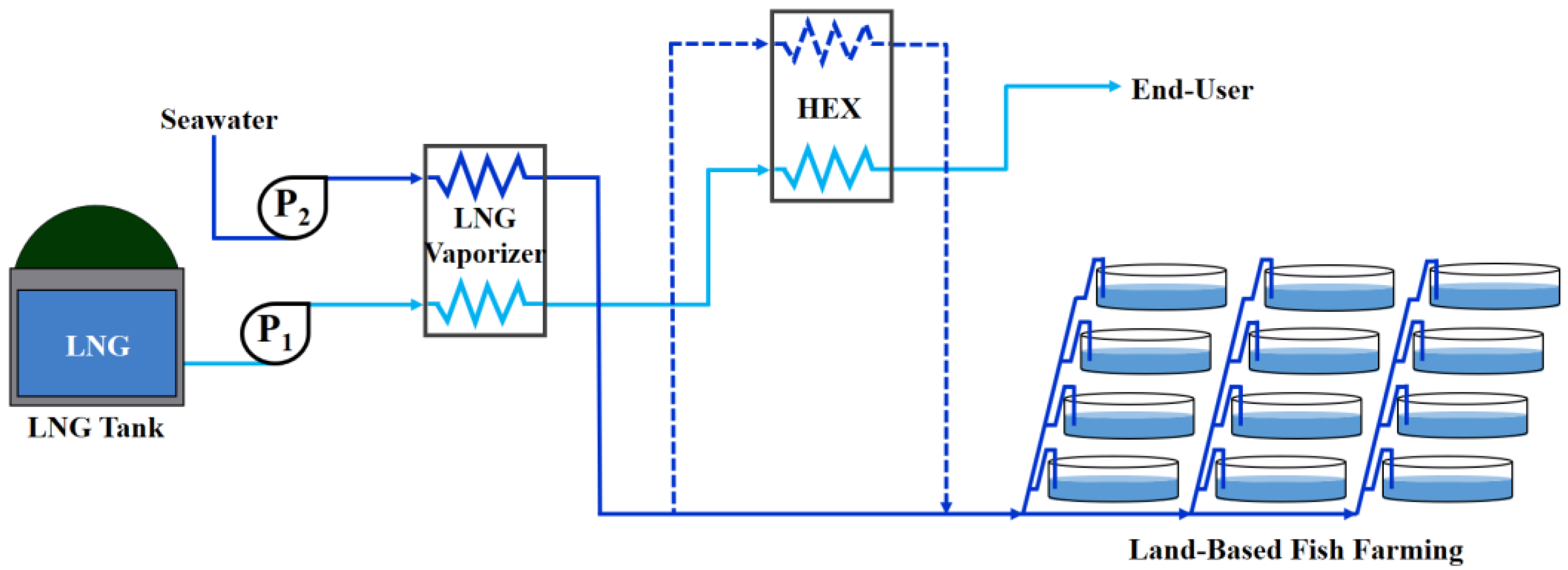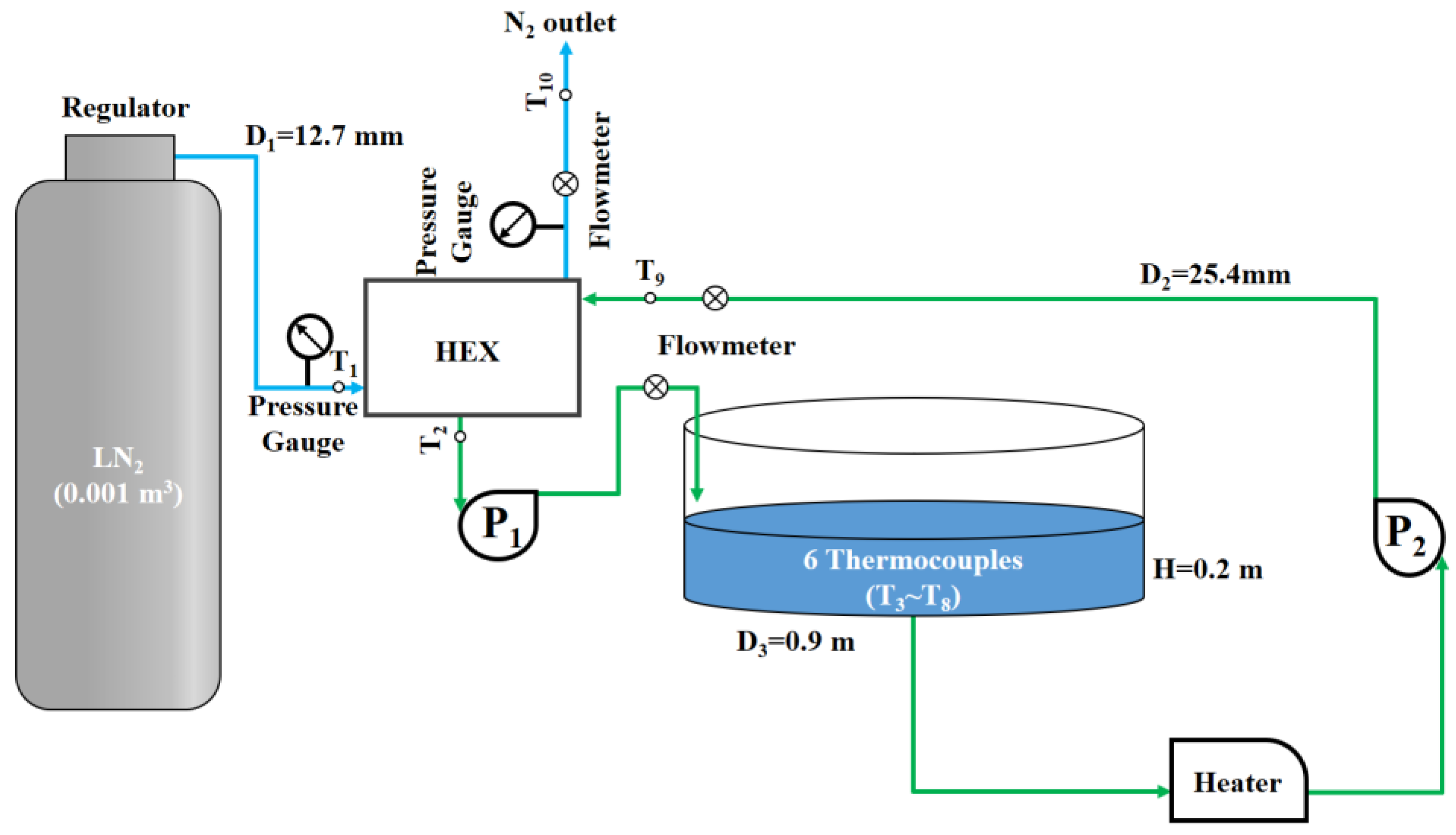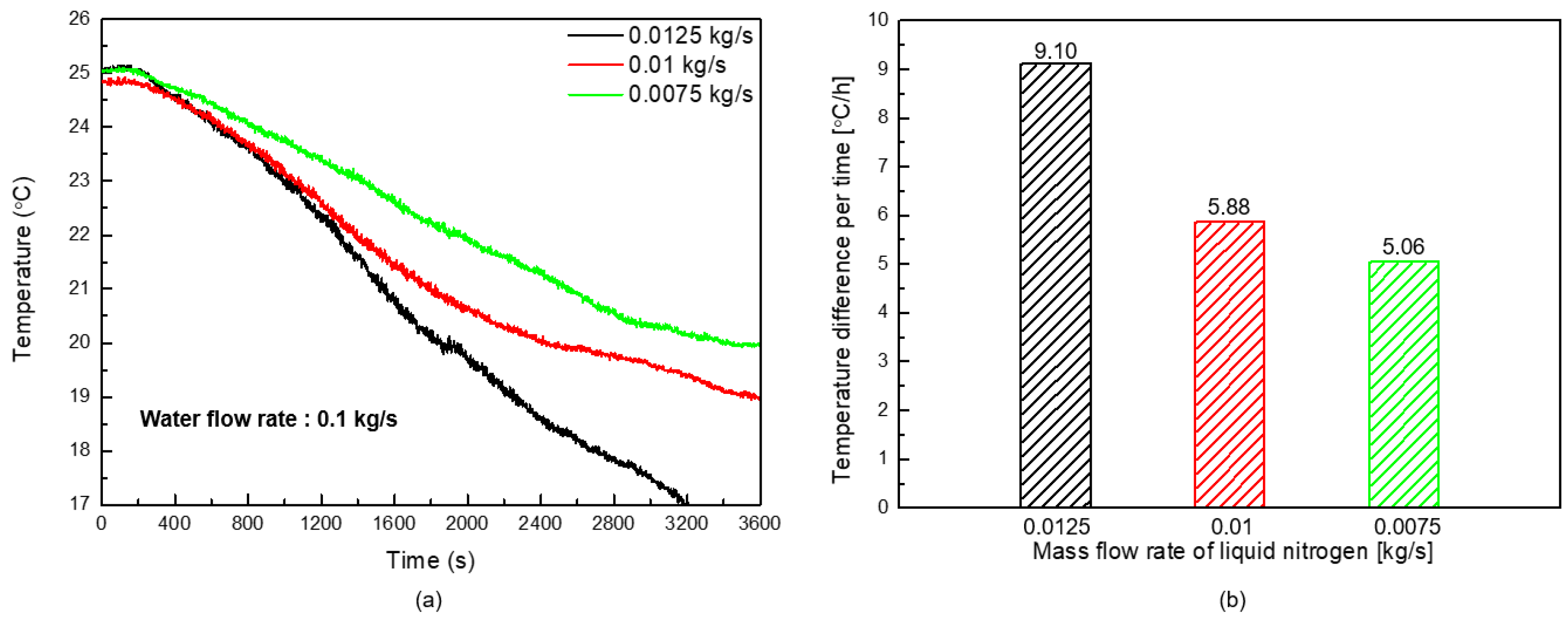Liquefied Natural Gas Cold Energy Utilization for Land-Based Cold Water Fish Aquaculture in South Korea
Abstract
1. Introduction
2. LNG Cold Energy Utilization
2.1. LNG Cryogenic Utilization of Power Generation Cycle
2.2. LNG Cryogenic Utilization of Air Separation Process
2.3. Cold water Fish Aquaculture
3. Experimental Details
(uncertainty of pressure measurement)2 + (uncertainty of water flow measurement)2 + (uncertainty of nitrogen
flow measurement)2] = square root of [(0.75)2 + (1.5)2 + (1.0)2 + (0.25)2] = 1.969%
4. Results and Discussion
4.1. Farming Tank Cooling Performance
4.1.1. Effect of the Mass Flow Rate of Liquid Nitrogen
4.1.2. Effect of the Mass Flow Rate of Water
4.2. Estimating Atlantic Salmon Production Capacity
5. Conclusions
Author Contributions
Funding
Conflicts of Interest
References
- Energy Information Administration (EIA). International Energy Outlook 2021; EIA: Wadhington, DC, USA, 2021. [Google Scholar]
- ExxonMobil. Outlook for Energy: A Perspective to 2040; ExxonMobil Corporation: Irving, TX, USA, 2019. [Google Scholar]
- British Petrol (BP). Energy Outlook, 2020th ed.; BP p.l.c.: London, UK, 2020. [Google Scholar]
- Kanbur, B.B.; Xiang, L.; Dubey, S.; Choo, F.H.; Duan, F. Cold utilization systems of LNG: A review. Renew. Sustain. Energy Rev. 2017, 79, 1171–1188. [Google Scholar] [CrossRef]
- Mokhatab, S.; Mak, J.Y.; Valappil, K.V.; Wood, D.A. Handbook of Liquefied Natural Gas; Elsvier Science: Burlington, ON, Canada, 2013. [Google Scholar]
- Ouyang, T.; Xie, S.; Wu, W.; Tan, J. A novel design of cold energy cascade utilization with advanced peak-shaving strategy integrated liquid air energy storage. J. Clean. Prod. 2021, 324, 129493. [Google Scholar] [CrossRef]
- Pospíšil, J.; Charvát, P.; Arsenyeva, O.; Klimeš, L.; Špiláček, M.; Klemeš, J.J. Energy demand of liquefaction and regasification of natural gas and the potential of LNG for operative thermal energy storage. Renew. Sustain. Energy Rev. 2019, 99, 1–15. [Google Scholar]
- He, T.; Chong, Z.R.; Zheng, J.; Ju, Y.; Linga, P. LNG cold energy utilization: Prospects and challenges. Energy 2019, 170, 557–568. [Google Scholar] [CrossRef]
- Hirakawa, S.; Kosugi, K. Utilization of LNG cold. Int. J. Refrig. 1981, 4, 17–21. [Google Scholar] [CrossRef]
- Food & Agriculture Organization (FAO). The State of World Fisheries and Aquaculture 2020; FAO: Rome, Italy, 2020. [Google Scholar]
- Asche, F.; Sikveland, M.; Zhang, D. Profitability in Norwegian salmon farming: The impact of firm size and price variability. Aquac. Econ. Manag. 2018, 21, 306–317. [Google Scholar] [CrossRef]
- Misund, B.; Nygård, R. Big fish: Valuation of the world’s largest salmon farming companies. Mar. Resour. Econ. 2018, 33, 245–261. [Google Scholar] [CrossRef]
- Brækkan, E.H.; Thyholdt, S.B.; Asche, F.; Myrland, Ø. The demands they are a-changin’. Eur. Rev. Agric. Econ. 2018, 45, 531–552. [Google Scholar] [CrossRef]
- Duston, J.; Saunders, R.L.; Knox, D.E. Effects of increases in freshwater temperature on loss of smolt characteristics in Atlantic salmon (Salmo salar). Can. J. Fish. Aquat. Sci. 1991, 48, 164–169. [Google Scholar] [CrossRef]
- Gamperl, A.K.; Ajiboye, O.O.; Zanuzzo, F.S.; Sandrelli, R.M.; Peroni, E.D.F.C.; Beemelmanns, A. The impacts of increasing temperature and moderate hypoxia on the production characteristics, cardiac morphology and haematology of Atlantic Salmon (Salmo salar). Aquaculture 2020, 519, 734874. [Google Scholar] [CrossRef]
- Jonsson, B.; Ruud-Hansen, J. Water temperature as the primary influence on timing of seaward migrations of Atlantic salmon (Salmo salar) smolts. Can. J. Fish. Aquat. Sci. 1985, 42, 593–595. [Google Scholar] [CrossRef]
- Nisembaum, L.G.; Martin, P.; Fuentes, M.; Besseau, L.; Magnanou, E.; McCormick, S.D.; Falcón, J. Effects of a temperature rise on melatonin and thyroid hormones during smoltification of Atlantic salmon, Salmo salar. J. Comp. Physiol. B 2020, 190, 731–748. [Google Scholar] [CrossRef] [PubMed]
- Sambraus, F.; Fjelldal, P.G.; Remø, S.C.; Hevrøy, E.M.; Nilsen, T.O.; Thorsen, A.; Hansen, T.J.; Waagbø, R. Water temperature and dietary histidine affect cataract formation in Atlantic salmon (Salmo salar L.) diploid and triploid yearling smolt. J. Fish Dis. 2017, 40, 1195–1212. [Google Scholar] [CrossRef] [PubMed]
- Ministry of the Interior and Safety. Seawater Temperature near LNG Production Sites. Korea Gas Corporation. Available online: https://www.data.go.kr/data/15040984/fileData.do#layer_data_infomation (accessed on 3 August 2020).
- Crespi, F.; Gavagnin, G.; Sánchez, D.; Martínez, G.S. Supercritical carbon dioxide cycles for power generation: A review. Appl. Energy 2017, 195, 152–183. [Google Scholar] [CrossRef]
- He, T.; Nair, S.K.; Babu, P.; Linga, P.; Karimi, I.A. A novel conceptual design of hydrate based desalination (HyDesal) process by utilizing LNG cold energy. Appl. Energy 2018, 222, 13–24. [Google Scholar] [CrossRef]
- Naseri, A.; Bidi, M.; Ahmadi, M.H.; Saidur, R. Exergy analysis of a hydrogen and water production process by a solar-driven transcritical CO2 power cycle with Stirling engine. J. Clean. Prod. 2017, 158, 165–181. [Google Scholar] [CrossRef]
- Hisazumi, Y.; Yamasaki, Y.; Sugiyama, S. Proposal for a high efficiency LNG power generation system utilizing waste heat from the combined cycle. Appl. Energy 1998, 60, 169–182. [Google Scholar] [CrossRef]
- Lee, S. Multi-parameter optimization of cold energy recovery in cascade Rankine cycle for LNG regasification using genetic algorithm. Energy 2017, 118, 776–782. [Google Scholar] [CrossRef]
- Kim, D.; Giametta, R.E.H.; Gundersen, T. Optimal use of liquefied natural gas (LNG) cold energy in air separation units. Ind. Eng. Chem. Res. 2018, 57, 5914–5923. [Google Scholar] [CrossRef]
- Ebrahimi, A.; Ziabasharhagh, M. Optimal design and integration of a cryogenic air separation unit (ASU) with liquefied natural gas (LNG) as heat sink, thermodynamic and economic analyses. Energy 2017, 126, 868–885. [Google Scholar] [CrossRef]
- Kim, H.; Hong, S. Review on economical efficiency of LNG cold energy use in South Korea. In Proceedings of the 23rd World Gas Conference, Amsterdam, The Netherlands, 5–9 June 2006. [Google Scholar]
- Liu, H.F.; Bi, C.W.; Zhao, Y.P. Experimental and numerical study of the hydrodynamic characteristics of a semisubmersible aquaculture facility in waves. Ocean Eng. 2020, 214, 107714. [Google Scholar] [CrossRef]
- Miao, Y.J.; Ding, J.; Tian, C.; Chen, X.J.; Fan, Y.L. Experimental and numerical study of a semi-submersible offshore fish farm under waves. Ocean Eng. 2021, 225, 108794. [Google Scholar] [CrossRef]
- Zhang, J.; Shimizu, H.; Nakashima, H.; Mizukami, Y.; Yoshida, T.; Liu, L.; Kitazawa, D. Water-tank experiment and static numerical analysis of the mooring system of a controllable depth cage. Aquac. Eng. 2020, 91, 102118. [Google Scholar] [CrossRef]
- Kitazawa, D.; Mizukami, Y.; Kanehira, M.; Takeuchi, Y.; Ito, S. Water tank and field tests on the performance of a submergible fish cage for farming silver salmon. In Proceedings of the 36th International Conference on Offshore Mechanics and Arctic Engineering, Rondheim, Norway, 25–30 June 2017. [Google Scholar]
- Boltaña, S.; Sanhueza, N.; Aguilar, A.; Gallardo-Escarate, C.; Arriagada, G.; Valdes, J.A.; Soto, D.; Quiñones, R.A. Influences of thermal environment on fish growth. Ecol. Evol. 2017, 7, 6814–6825. [Google Scholar] [CrossRef] [PubMed]
- Cheng, H.; Yin, L.; Ju, Y.; Fu, Y. Experimental investigation on heat transfer characteristics of supercritical nitrogen in a heated vertical tube. I. J. Therm. Sci. 2020, 152, 106327. [Google Scholar] [CrossRef]
- Gorle, J.M.R.; Terjesen, B.F.; Mota, V.C.; Summerfelt, S. Water velocity in commercial RAS culture tanks for Atlantic salmon smolt production. Aquac. Eng. 2018, 81, 89–100. [Google Scholar] [CrossRef]
- Summerfelt, S.T.; Mathisen, F.; Holan, A.B.; Terjesen, B.F. Survey of large circular and octagonal tanks operated at Norwegian commercial smolt and post-smolt sites. Aquac. Eng. 2016, 74, 105–110. [Google Scholar] [CrossRef]
- Zhang, Z.E.J.; Chen, J.; Zhao, X.; Zhang, B.; Deng, Y.; Peng, Q.; Yin, X. Effects of boiling heat transfer on the performance enhancement of a medium speed diesel engine fueled with diesel and rapeseed methyl ester. Appl. Therm. Eng. 2020, 169, 114984. [Google Scholar] [CrossRef]
- Zhang, Z.; Li, J.; Tian, J.; Dong, R.; Zou, Z.; Gao, S.; Tan, D. Performance, combustion and emission characteristics investigations on a diesel engine fueled with diesel/ethanol/n-butanol blends. Energy 2022, 249, 123733. [Google Scholar] [CrossRef]
- Baek, S.; Shin, D.; Noh, J.; Choi, B.; Huh, S.; Jeong, H.; Sung, Y. Influence of surfactants on thermal performance of Al2O3/water nanofluids in a two-phase closed thermosyphon. Case Stud. Therm. Eng. 2021, 28, 101586. [Google Scholar] [CrossRef]
- Afrianto, H.; Tanshen, M.R.; Munkhbayar, B.; Tony Suryo, U.T.; Chung, H.; Jeong, H. A numerical investigation on LNG flow and heat transfer characteristic in heat exchanger. Int. J. Heat Mass Transf. 2014, 68, 110–118. [Google Scholar] [CrossRef]
- Korea Agro-Fisheries & Food Trade Corporation. Agriculture, Forestry and Fisheries Import & Export & Statics. Available online: https://www.kati.net/board/pubilshedMaterialsView.do?board_seq=91265&menu_dept2=48&dateSearch=all (accessed on 20 October 2020).







| Parameters | Reference | Experiment |
|---|---|---|
| Tank shape | Circular | Circular |
| Volume (m3) | 368 | 0.127 |
| Flow rate (kg/s) | 282 | 0.1 |
| HRT (min) | 22 | 22 |
| * Production capacity (ton) | 36.8 | 0.0127 |
| Measurements | Measuring Range | Accuracy | Uncertainty |
|---|---|---|---|
| Temperature measurement | 23–623 [K] | ±0.1 [K] | ±0.75% |
| Pressure measurement | 0–7.0 [MPa] | ±0.1 [MPa] | ±1.5% |
| Water flow measurement | 0.3–10 [LPM] | ±0.01 [LPM] | ±1.0% |
| Gas flow measurement | 0–12 [kg/min] | ±0.01 [kg/min] | ±0.25% |
| LNG Terminal | 2015 | 2016 | 2017 | 2018 | 2019 |
|---|---|---|---|---|---|
| Tongyeong | 5,921,544 [ton] | 6,537,572 [ton] | 6,149,512 [ton] | 7,460,843 [ton] | 6,953,727 [ton] |
| Species | 2017 | 2018 | 2019 | ||||
|---|---|---|---|---|---|---|---|
| Weight [ton] | Cost (1000 USD) | Weight [ton] | Cost (1000 USD) | Weight [ton] | Cost (1000 USD) | ||
| 1 | Pollack | 259,252 | 420,285 | 253,952 | 428,736 | 180,354 | 371,560 |
| 2 | Salmon | 30,272 | 295,433 | 38,318 | 375,155 | 38,003 | 362,469 |
| 3 | Tuna | 24,954 | 229,352 | 14,845 | 256,310 | 23,871 | 245,647 |
| 4 | Yellow croaker | 23,198 | 109,430 | 27,798 | 128,291 | 27,450 | 122,677 |
| 5 | Brown croaker | 23,743 | 96,501 | 25,807 | 113,801 | 23,816 | 100,764 |
Publisher’s Note: MDPI stays neutral with regard to jurisdictional claims in published maps and institutional affiliations. |
© 2022 by the authors. Licensee MDPI, Basel, Switzerland. This article is an open access article distributed under the terms and conditions of the Creative Commons Attribution (CC BY) license (https://creativecommons.org/licenses/by/4.0/).
Share and Cite
Baek, S.; Choi, W.; Kim, G.; Seo, J.; Lee, S.; Jeong, H.; Sung, Y. Liquefied Natural Gas Cold Energy Utilization for Land-Based Cold Water Fish Aquaculture in South Korea. Energies 2022, 15, 7322. https://doi.org/10.3390/en15197322
Baek S, Choi W, Kim G, Seo J, Lee S, Jeong H, Sung Y. Liquefied Natural Gas Cold Energy Utilization for Land-Based Cold Water Fish Aquaculture in South Korea. Energies. 2022; 15(19):7322. https://doi.org/10.3390/en15197322
Chicago/Turabian StyleBaek, Seungyeop, Wontak Choi, Gyuchang Kim, Jaedeok Seo, Sanggon Lee, Hyomin Jeong, and Yonmo Sung. 2022. "Liquefied Natural Gas Cold Energy Utilization for Land-Based Cold Water Fish Aquaculture in South Korea" Energies 15, no. 19: 7322. https://doi.org/10.3390/en15197322
APA StyleBaek, S., Choi, W., Kim, G., Seo, J., Lee, S., Jeong, H., & Sung, Y. (2022). Liquefied Natural Gas Cold Energy Utilization for Land-Based Cold Water Fish Aquaculture in South Korea. Energies, 15(19), 7322. https://doi.org/10.3390/en15197322







